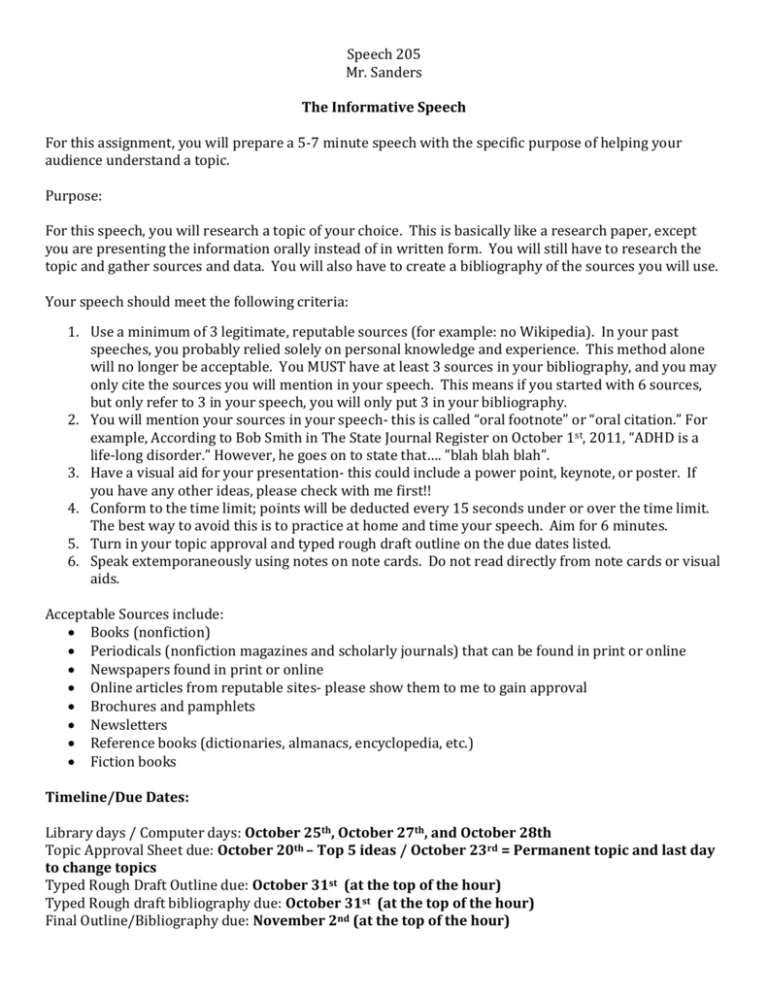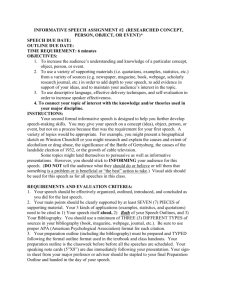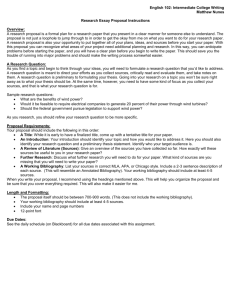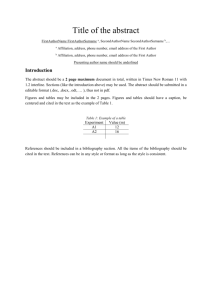Speech - Informative
advertisement

Speech 205 Mr. Sanders The Informative Speech For this assignment, you will prepare a 5-7 minute speech with the specific purpose of helping your audience understand a topic. Purpose: For this speech, you will research a topic of your choice. This is basically like a research paper, except you are presenting the information orally instead of in written form. You will still have to research the topic and gather sources and data. You will also have to create a bibliography of the sources you will use. Your speech should meet the following criteria: 1. Use a minimum of 3 legitimate, reputable sources (for example: no Wikipedia). In your past speeches, you probably relied solely on personal knowledge and experience. This method alone will no longer be acceptable. You MUST have at least 3 sources in your bibliography, and you may only cite the sources you will mention in your speech. This means if you started with 6 sources, but only refer to 3 in your speech, you will only put 3 in your bibliography. 2. You will mention your sources in your speech- this is called “oral footnote” or “oral citation.” For example, According to Bob Smith in The State Journal Register on October 1st, 2011, “ADHD is a life-long disorder.” However, he goes on to state that…. ”blah blah blah”. 3. Have a visual aid for your presentation- this could include a power point, keynote, or poster. If you have any other ideas, please check with me first!! 4. Conform to the time limit; points will be deducted every 15 seconds under or over the time limit. The best way to avoid this is to practice at home and time your speech. Aim for 6 minutes. 5. Turn in your topic approval and typed rough draft outline on the due dates listed. 6. Speak extemporaneously using notes on note cards. Do not read directly from note cards or visual aids. Acceptable Sources include: Books (nonfiction) Periodicals (nonfiction magazines and scholarly journals) that can be found in print or online Newspapers found in print or online Online articles from reputable sites- please show them to me to gain approval Brochures and pamphlets Newsletters Reference books (dictionaries, almanacs, encyclopedia, etc.) Fiction books Timeline/Due Dates: Library days / Computer days: October 25th, October 27th, and October 28th Topic Approval Sheet due: October 20th – Top 5 ideas / October 23rd = Permanent topic and last day to change topics Typed Rough Draft Outline due: October 31st (at the top of the hour) Typed Rough draft bibliography due: October 31st (at the top of the hour) Final Outline/Bibliography due: November 2nd (at the top of the hour) Topic Approval Form Your Name: Speech topic or Title (be sure it is not persuasive!): General Purpose: To inform (DO NOT WRITE ANYTHING ELSE HERE) Specific Purpose: To inform my audience about… Central Idea (this would be like a thesis statement for your speech- you are informing about ______________ because ___________): Here is where you will find out if your topic is approved, or if we need to further discuss your topic: Topic Approved ______________________________________ See me __________________________________________________ The Outline The outline for your informative speech will be the same format as your Demonstration Speech, EXCEPT, whereas last time you listed the items you used off to the side, this time you will list the source you will mention off to the side… There is an example of a good outline in this packet. Also, refer to the outline sheet you received for your Demonstration speech if you forgot the format. Bibliography Format You will use MLA format to create your bibliography- remember also, that with a speech, your bibliography comes immediately after your outline, not on a separate page. Please refer to the MLA handout before you start your bibliography. Stu Dent Informative Speech October 7, 2011 3rd Hour Eating Healthy with a Busy Lifestyle General Purpose: To inform Specific Purpose: To inform the audience about eating healthy while on the run Central Idea: A healthy lifestyle is still doable if you make wise choices. I. Introduction A. Attention getter: pictures of healthy food B. Thesis: Therefore, it is imperative that we learn about… because… C. Reason to listen: learn more about taking care of your health D. Preview: So today I will first talk about… 2nd… Before finally…. II. Body A. Pack your lunch 1. Healthier 2. Less expensive 3. Many options a. pre-cooked, pre-cut b. fruit cups c. veggies 4. Prepare in advance 5. Quick meals a. Lean Cuisine b. Healthy Choice B. Eating in Restaurants 1. Healthier choices available a. Salads b. Baked or grilled entres c. Low-carb options 2. Healthier restaurants available a. Subway b. Sweet Tomatoes C. Keep healthy snacks accessible 1. Fruit 2. Yogurt smoothies 3. Water *mention Mayer *mention Brown *mention Carter III. Conclusion A. In conclusion, there are many options available. Today we talked about 1st… 2nd… and finally… B. So remember, making the choice doesn’t have to be hard. Eat healthy, eat smart, eat well. Bibliography Brown, Alexandra. "The Rise of the New Restaurant." Tulsa Studies in Women's Literature 12.6 (2009): 48-62. Print. Carter, L., and Margaret Shaffer. “A Quick Fix.” Good Housekeeping Mar. 2006: 143-48. Print. Mayer, Sarah. Creating a Healthy Lifestyle. New York: Harper, 2008. Name _________________________________________________________________________________________ Date _________________________ Informative Speech Title of Speech: ______________________________________________________________________________________________________________________________________ Category Introduction Body Structure Content Visual Aid Speaker credibility Nonverbal physical delivery Verbal/vocal delivery Conclusion Outline Conformity to assignment Grading Criteria (rated 1-10 per category) E- excellent (no flaws at all) M- meets criteria B- below expectations 0- not present E M B 0 Attention Getting Device (AGD) E M B 0 Thesis Statement (Claim + Reason) E M B 0 Reason to Listen E M B 0 Preview/Summary E M B 0 appropriate organizational pattern E M B 0 clear and logical E M B 0 followed outline E M B 0 transitions between topics E M B 0 main points clearly stated E M B 0 main points clearly explained E M B 0 main points supported by accurate research E M B 0 oral citations met (at least 3) E M B 0 necessary and appropriate E M B 0 presented skillfully E M B 0 well designed (color, size, etc.) E M B 0 professional (neatness, spelling, etc.) E M B 0 audience can see (view not blocked) E M B 0 knowledgeable E M B 0 dressed appropriately E M B 0 enthusiasm for the topic E M B 0 confident E M B 0 honest/ethical E M B 0 eye contact E M B 0 posture E M B 0 avoided distracting mannerisms E M B 0 facial expressions E M B 0 gestures E M B 0 vocal enthusiasm E M B 0 rate/fluency (avoided dead air) E M B 0 volume E M B 0 avoided offensive language E M B 0 avoided fillers (um, uh, like, yeah, etc. ) E M B 0 clarity E M B 0 correct grammar and word usage E M B 0 Review Statement E M B 0 Clincher statement E M B 0 ending and departure (avoid “that’s it,” etc.) E M B 0 appropriate length E M B 0 outline complete with all parts present E M B 0 format correct E M B 0 bibliography requirements met (at least 3) E M B 0 time limit met (5-7 minutes) E M B 0 topic approved E M B 0 spoke extemporaneously E M B 0 source requirements met (at least 3) Score (out of 100 points possible) Penalties Late? Gum? Speaking or being distracting during other speeches? Total 90-100 A 80-89 B 70-79 C 60-69 D 0-59 F Score







